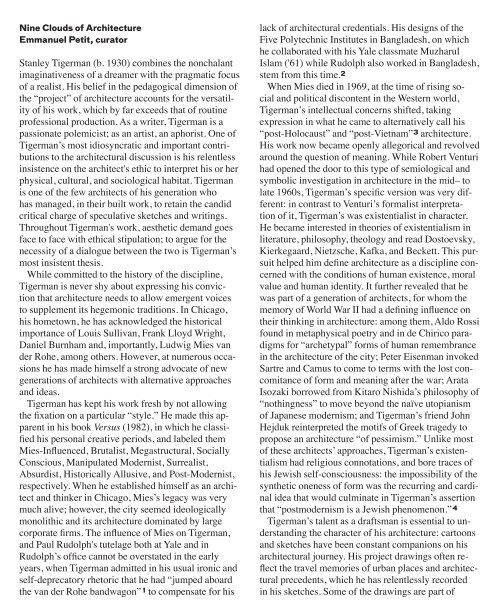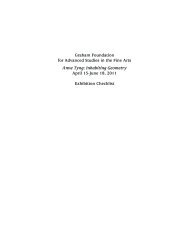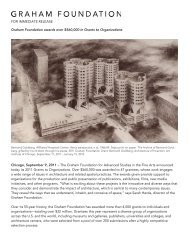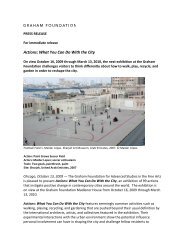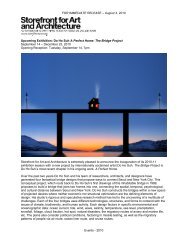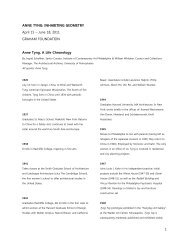Nine Clouds of Architecture, Essay by Emmanuel Petit - Graham ...
Nine Clouds of Architecture, Essay by Emmanuel Petit - Graham ...
Nine Clouds of Architecture, Essay by Emmanuel Petit - Graham ...
Create successful ePaper yourself
Turn your PDF publications into a flip-book with our unique Google optimized e-Paper software.
<strong>Nine</strong> <strong>Clouds</strong> <strong>of</strong> <strong>Architecture</strong><br />
<strong>Emmanuel</strong> <strong>Petit</strong>, curator<br />
Stanley Tigerman (b. 1930) combines the nonchalant<br />
imaginativeness <strong>of</strong> a dreamer with the pragmatic focus<br />
<strong>of</strong> a realist. His belief in the pedagogical dimension <strong>of</strong><br />
the “project” <strong>of</strong> architecture accounts for the versatility<br />
<strong>of</strong> his work, which <strong>by</strong> far exceeds that <strong>of</strong> routine<br />
pr<strong>of</strong>essional production. As a writer, Tigerman is a<br />
passionate polemicist; as an artist, an aphorist. One <strong>of</strong><br />
Tigerman’s most idiosyncratic and important contributions<br />
to the architectural discussion is his relentless<br />
insistence on the architect's ethic to interpret his or her<br />
physical, cultural, and sociological habitat. Tigerman<br />
is one <strong>of</strong> the few architects <strong>of</strong> his generation who<br />
has managed, in their built work, to retain the candid<br />
critical charge <strong>of</strong> speculative sketches and writings.<br />
Throughout Tigerman's work, aesthetic demand goes<br />
face to face with ethical stipulation; to argue for the<br />
necessity <strong>of</strong> a dialogue between the two is Tigerman’s<br />
most insistent thesis.<br />
While committed to the history <strong>of</strong> the discipline,<br />
Tigerman is never shy about expressing his conviction<br />
that architecture needs to allow emergent voices<br />
to supplement its hegemonic traditions. In Chicago,<br />
his hometown, he has acknowledged the historical<br />
importance <strong>of</strong> Louis Sullivan, Frank Lloyd Wright,<br />
Daniel Burnham and, importantly, Ludwig Mies van<br />
der Rohe, among others. However, at numerous occasions<br />
he has made himself a strong advocate <strong>of</strong> new<br />
generations <strong>of</strong> architects with alternative approaches<br />
and ideas.<br />
Tigerman has kept his work fresh <strong>by</strong> not allowing<br />
the fixation on a particular “style.” He made this apparent<br />
in his book Versus (1982), in which he classified<br />
his personal creative periods, and labeled them<br />
Mies-Influenced, Brutalist, Megastructural, Socially<br />
Conscious, Manipulated Modernist, Surrealist,<br />
Absurdist, Historically Allusive, and Post-Modernist,<br />
respectively. When he established himself as an architect<br />
and thinker in Chicago, Mies’s legacy was very<br />
much alive; however, the city seemed ideologically<br />
monolithic and its architecture dominated <strong>by</strong> large<br />
corporate firms. The influence <strong>of</strong> Mies on Tigerman,<br />
and Paul Rudolph's tutelage both at Yale and in<br />
Rudolph’s <strong>of</strong>fice cannot be overstated in the early<br />
years, when Tigerman admitted in his usual ironic and<br />
self-deprecatory rhetoric that he had “jumped aboard<br />
the van der Rohe bandwagon” 1 to compensate for his<br />
lack <strong>of</strong> architectural credentials. His designs <strong>of</strong> the<br />
Five Polytechnic Institutes in Bangladesh, on which<br />
he collaborated with his Yale classmate Muzharul<br />
Islam ('61) while Rudolph also worked in Bangladesh,<br />
stem from this time. 2<br />
When Mies died in 1969, at the time <strong>of</strong> rising social<br />
and political discontent in the Western world,<br />
Tigerman’s intellectual concerns shifted, taking<br />
expression in what he came to alternatively call his<br />
“post-Holocaust” and “post-Vietnam” 3 architecture.<br />
His work now became openly allegorical and revolved<br />
around the question <strong>of</strong> meaning. While Robert Venturi<br />
had opened the door to this type <strong>of</strong> semiological and<br />
symbolic investigation in architecture in the mid– to<br />
late 1960s, Tigerman’s specific version was very different:<br />
in contrast to Venturi’s formalist interpretation<br />
<strong>of</strong> it, Tigerman’s was existentialist in character.<br />
He became interested in theories <strong>of</strong> existentialism in<br />
literature, philosophy, theology and read Dostoevsky,<br />
Kierkegaard, Nietzsche, Kafka, and Beckett. This pursuit<br />
helped him define architecture as a discipline concerned<br />
with the conditions <strong>of</strong> human existence, moral<br />
value and human identity. It further revealed that he<br />
was part <strong>of</strong> a generation <strong>of</strong> architects, for whom the<br />
memory <strong>of</strong> World War II had a defining influence on<br />
their thinking in architecture: among them, Aldo Rossi<br />
found in metaphysical poetry and in de Chirico paradigms<br />
for “archetypal” forms <strong>of</strong> human remembrance<br />
in the architecture <strong>of</strong> the city; Peter Eisenman invoked<br />
Sartre and Camus to come to terms with the lost concomitance<br />
<strong>of</strong> form and meaning after the war; Arata<br />
Isozaki borrowed from Kitaro Nishida’s philosophy <strong>of</strong><br />
“nothingness” to move beyond the naïve utopianism<br />
<strong>of</strong> Japanese modernism; and Tigerman’s friend John<br />
Hejduk reinterpreted the motifs <strong>of</strong> Greek tragedy to<br />
propose an architecture “<strong>of</strong> pessimism.” Unlike most<br />
<strong>of</strong> these architects’ approaches, Tigerman’s existentialism<br />
had religious connotations, and bore traces <strong>of</strong><br />
his Jewish self-consciousness: the impossibility <strong>of</strong> the<br />
synthetic oneness <strong>of</strong> form was the recurring and cardinal<br />
idea that would culminate in Tigerman’s assertion<br />
that “postmodernism is a Jewish phenomenon.” 4<br />
Tigerman’s talent as a draftsman is essential to understanding<br />
the character <strong>of</strong> his architecture: cartoons<br />
and sketches have been constant companions on his<br />
architectural journey. His project drawings <strong>of</strong>ten reflect<br />
the travel memories <strong>of</strong> urban places and architectural<br />
precedents, which he has relentlessly recorded<br />
in his sketches. Some <strong>of</strong> the drawings are part <strong>of</strong>


